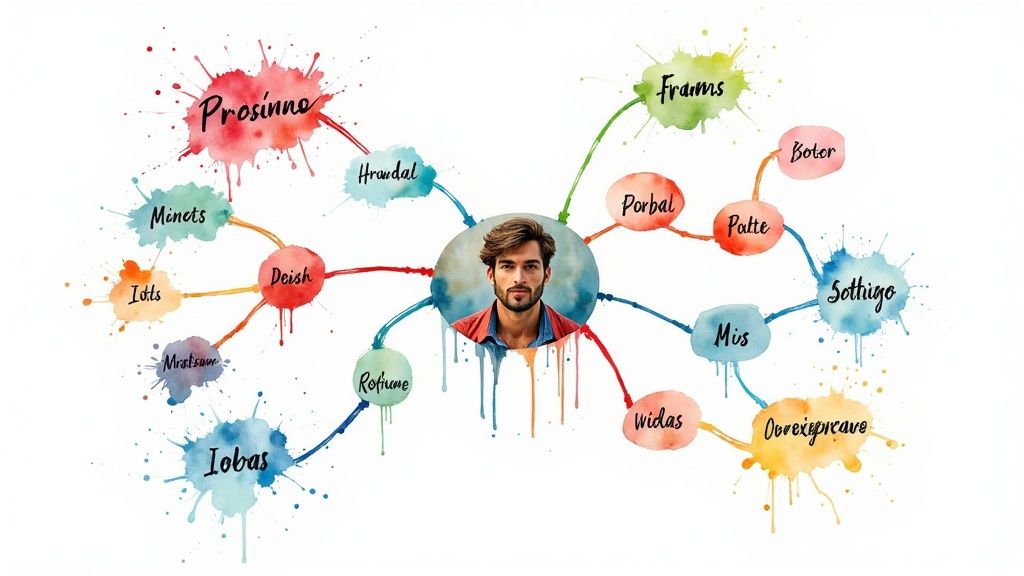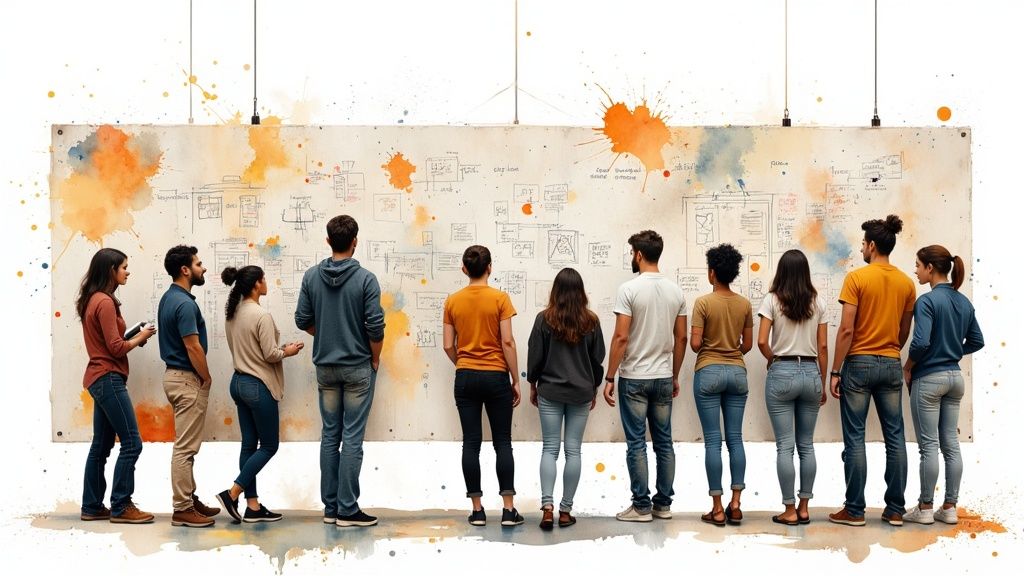
7 Proven Methods for Idea Generation: Essential Strategies That Actually Work
Understanding Why Traditional Idea Generation Falls Short

Brainstorming has long been the go-to method for generating new ideas, but research shows it often fails to deliver the creative breakthroughs teams need. Several key factors limit its effectiveness in practice. Most notably, "production blocking" occurs when group members must wait their turn to share ideas. Picture a team of ten people in a brainstorming session – while one person speaks, nine others sit holding potentially brilliant ideas that may fade before they get a chance to voice them. This creates a major bottleneck in the creative process.
The social dynamics of traditional brainstorming can also stifle creativity. Team members, especially more junior staff, often hesitate to share unconventional ideas for fear of judgment or criticism from their peers and managers. This self-censorship means many potentially groundbreaking concepts never see the light of day. Instead of fostering innovation, brainstorming sessions tend to produce safe, predictable suggestions that don't push boundaries.
The data confirms these observations aren't just anecdotal. A compelling 1991 meta-analysis found that individuals working independently generated 83% more ideas than groups brainstorming together. This striking statistic highlights the significant limitations of relying solely on traditional group brainstorming. However, this doesn't mean we should abandon collaboration entirely – rather, we need smarter approaches that overcome these inherent constraints.
Overcoming the Limitations of Traditional Brainstorming
Teams can take several practical steps to create more effective ideation processes. One key approach is adopting hybrid methods that combine individual and group work. For example, having team members first brainstorm independently before coming together allows everyone to fully develop their thoughts without interruption. When the group then convenes to share and build on ideas, they have a rich foundation of well-considered concepts to work with.
Adding structure to brainstorming sessions also leads to better results. Rather than open-ended discussions, using specific frameworks helps guide thinking in productive directions. The SCAMPER method (Substitute, Combine, Adapt, Modify, Put to other uses, Eliminate, and Reverse) gives teams clear prompts for examining problems from different angles. Similarly, the "Six Thinking Hats" technique encourages participants to deliberately switch between different thinking modes – from purely factual analysis to creative exploration to critical evaluation.
By addressing the core weaknesses of traditional brainstorming while preserving its collaborative benefits, these enhanced approaches help teams tap into their full creative potential. The key is creating an environment where everyone feels safe sharing unconventional ideas and has the space to think deeply. With the right structure and balance of individual and group work, teams can consistently generate more innovative solutions to complex challenges.
Building a Framework for Consistent Creative Output

Putting together a creative team is only the first step – the real challenge lies in establishing systems that reliably produce great ideas. Success requires moving beyond casual brainstorming to create a structured yet flexible framework that draws out the best from both individual and group creativity. Let's explore practical ways to build this framework and generate a steady stream of strong ideas.
Structuring Ideation Sessions for Optimal Results
Just like a well-designed building needs solid foundations, productive ideation sessions need clear structure. Start by clearly outlining the problem to solve, setting specific time blocks for different activities, and establishing basic ground rules. For example, you might begin with 15 minutes of solo brainstorming, then move into 30 minutes of group discussion to build on the best ideas. This combination of independent thinking followed by collaborative refinement helps prevent common pitfalls like groupthink while encouraging diverse perspectives.
Combining Individual Reflection with Group Dynamics
Finding the right balance between solo and group work is crucial for idea generation. Think of it like musicians practicing individually before coming together for orchestra rehearsal – both elements are essential. Give team members quiet time to explore ideas independently using techniques like mind mapping or SCAMPER. This individual reflection allows people to develop their thoughts without immediate judgment. When the group reconvenes, these initial ideas become building blocks for even better solutions through discussion and refinement.
Balancing Structured Processes with Creative Freedom
While clear processes are important, too much rigidity can stifle creativity. The key is providing enough structure to guide ideation while leaving room for spontaneous exploration. Consider how jazz musicians work within a basic chord progression while freely improvising – your framework should similarly combine consistent methods with space for creative leaps. Plan structured activities but also include open periods where ideas can flow naturally and unexpected connections can emerge.
Practical Frameworks and Techniques for Immediate Implementation
Several proven methods can strengthen your ideation process. Edward de Bono's Six Thinking Hats technique helps teams examine problems from multiple angles – emotional, analytical, creative, and more. The Lotus Blossom method expands ideas outward from a central concept, creating networks of related possibilities. By incorporating these and other structured approaches while maintaining creative flexibility, teams can develop reliable systems for generating breakthrough ideas. The goal is establishing repeatable processes that consistently produce quality solutions while keeping innovation alive.
Leveraging Digital Tools for Enhanced Ideation
While having a solid framework for generating ideas is essential, digital tools can take the process to new heights. Modern technology opens up fresh possibilities for creative exploration beyond traditional in-person meetings. Teams can now generate and develop ideas in ways that weren't possible before.
Digital Tools: Expanding the Horizons of Idea Generation
Digital platforms solve many common challenges that limit traditional brainstorming. For instance, online tools allow people to contribute ideas whenever inspiration strikes, rather than being constrained to scheduled meetings. Many platforms also include anonymous sharing options, which helps people feel more comfortable expressing their thoughts without fear of judgment. This creates an environment where everyone can participate fully.
Choosing the Right Tool for the Job: A Categorized Approach
With so many options available, it helps to organize digital tools based on their main purposes:
-
Mind Mapping and Visualization Tools: Programs like XMind and Miro help teams map out and connect ideas visually. They work especially well for complex topics where you need to see relationships between concepts. Think of them as flexible digital whiteboards with added collaboration features.
-
Brainstorming and Idea Capture Platforms: Tools like Stormboard and IdeaFlip focus specifically on gathering and organizing ideas during group sessions. Features like voting and commenting make it easy to spot the most promising concepts.
-
Collaboration and Project Management Software: Platforms like Asana, Trello, and Slack can double as idea generation spaces within ongoing projects. Team members can share thoughts, give feedback, and track progress all in one place.
-
AI-Powered Ideation Tools: New AI platforms can analyze data, spot patterns, and suggest novel ideas based on specific prompts. While helpful, these tools work best as aids to human creativity rather than replacements.
Best Practices for Leveraging Digital Tools
Getting the most value from digital tools requires a thoughtful approach:
-
Establish Clear Objectives: Know exactly what you want to achieve and pick tools that match those goals.
-
Provide Training and Support: Make sure everyone knows how to use the chosen platforms effectively. Proper training prevents frustration and enables full participation.
-
Facilitate Active Participation: Encourage input from all team members regardless of role or location. Digital tools can help include diverse perspectives.
-
Integrate with Existing Workflows: Connect new tools smoothly with current processes to avoid creating extra work or losing information.
-
Regularly Evaluate and Refine: Keep checking how well the tools are working and adjust based on team feedback and changing needs.
By thoughtfully implementing digital tools and following these guidelines, teams can significantly improve their idea generation process. The key is viewing digital tools not just as new technology, but as a way to fundamentally enhance creativity and collaboration. This allows organizations to develop better solutions and stay ahead in their field.
Creating an Environment That Nurtures Innovation

A supportive environment plays a key role in fostering creativity and idea generation. Without it, even the most brilliant methods will falter. Smart organizations know that the physical and psychological spaces they create directly impact their teams' ability to innovate. When done right, these spaces energize people and encourage them to share and build on each other's ideas openly. Let's explore the essential elements that help teams maximize their creative potential.
Building Psychological Safety: The Foundation of Open Ideation
At the core of effective idea generation is psychological safety – an environment where team members feel comfortable taking risks and sharing unconventional thoughts without fear of judgment or negative consequences. When people feel psychologically safe, they're more likely to contribute unique perspectives and challenge existing assumptions. This openness often leads to breakthrough ideas. However, in environments where criticism and judgment prevail, people tend to self-censor and hold back potentially valuable insights. The result is a significant drop in creative output and missed opportunities for innovation.
Embracing Creative Tension: The Spark for Breakthroughs
While psychological safety provides the foundation, productive creative tension helps drive innovation forward. This tension emerges naturally when teams explore the gap between current reality and future possibilities. When managed well, it motivates people to seek novel solutions and push beyond comfortable boundaries. For instance, Google found success with their "20% time" approach, where employees could dedicate one day per week to side projects. This structured way of encouraging exploration led to successful products like Gmail and Google News, showing how creative tension can thrive within clear boundaries.
Fostering an Atmosphere of Collaborative Exploration
The overall workspace atmosphere shapes how effectively teams generate and develop ideas together. When people feel empowered to freely share and build on each other's contributions, innovation flourishes. Key practices that support this include:
- Open Communication Channels: Create clear paths for sharing ideas, giving feedback, and tracking progress
- Cross-Functional Collaboration: Mix teams with different skills and viewpoints to spark new connections
- Regular Ideation Sessions: Schedule dedicated time for brainstorming and exploring specific challenges
- Celebration of Creativity: Recognize and reward creative contributions to reinforce their importance
By focusing on these core elements – psychological safety, productive creative tension, and collaborative exploration – organizations create the conditions where innovation can thrive. This enables teams to make the most of different idea generation approaches and consistently produce meaningful breakthroughs. The result is an ongoing cycle of creativity that drives continuous improvement and lasting success. When the environment truly supports innovation, it helps transform promising ideas into real-world impact.
Designing Effective Incentive Systems for Creativity

Good ideas don't just happen by chance – they need the right environment and incentives to flourish. Organizations that want to boost creativity must thoughtfully design systems that motivate people to share their best thinking. Money alone won't solve the challenge. The key is building frameworks that align rewards with innovation goals while tapping into what truly drives creative contributions.
The Psychology of Creative Incentives
Research shows that people's internal drive to create – their intrinsic motivation – plays a major role in sparking new ideas. When someone enjoys the creative process itself and feels challenged in a good way, they're more likely to generate novel solutions. External rewards like recognition can amplify this internal motivation. For instance, publicly acknowledging an employee's creative solution validates their efforts and encourages them to keep contributing.
A key study from Columbia University found that generic reward systems often backfire. When rewards aren't thoughtfully designed, people focus more on checking boxes to get the reward than on exploring truly original ideas. The most effective incentives specifically recognize the quality and real-world impact of creative contributions, not just the number of ideas submitted.
Striking a Balance: Recognition vs. Rewards
Organizations need to carefully balance different types of incentives. While financial rewards have their place, relying too heavily on monetary bonuses can actually hurt creativity. Research has found that big cash rewards for creative tasks tend to make people perform worse because the pressure to earn the reward blocks the free-thinking mindset needed for innovation. Simple recognition through praise, highlighting contributions in meetings, and offering growth opportunities often works better than pure financial incentives. These approaches tap into people's natural desire for mastery and belonging.
Practical Frameworks for Incentive Design
Building effective creative incentives requires a structured approach. Here are proven frameworks to consider:
- Tiered Recognition: Create different levels of acknowledgment based on contribution size – from quick verbal praise for initial ideas to formal recognition for successfully implemented solutions. This encourages ongoing participation at all levels.
- Idea Impact Measurement: Track concrete results of implemented ideas, such as efficiency gains or new revenue. Connecting rewards to measurable outcomes reinforces the real value of creative thinking.
- Peer-to-Peer Recognition: Enable team members to recognize each other's creative contributions. This builds a culture of appreciation and can motivate more powerfully than top-down recognition alone. Simple feedback platforms make this easy to implement.
- Creative Challenges and Competitions: Run focused innovation events around specific business problems, with recognition and modest rewards for winning solutions. These targeted initiatives generate useful ideas while energizing creative thinking.
By applying these frameworks thoughtfully and understanding what truly drives creative motivation, organizations can design incentive systems that consistently generate valuable ideas. The goal is finding approaches that tap into people's natural creative drive while strategically using external rewards to maximize both innovative output and business impact. Success comes from recognizing that creativity flourishes when people feel both internally motivated and externally valued for their contributions.
Implementing and Scaling Your Idea Generation System
Building an effective idea generation system requires careful planning, testing, and gradual expansion across your organization. When implemented thoughtfully, this structured approach helps create sustainable innovation that aligns with your company's goals. The key is to start small, gather feedback, and scale up methodically while measuring results along the way.
Starting Small: Piloting Your Idea Generation Methods
Begin by testing your chosen idea generation methods with a single team or department. This controlled pilot program provides real-world insights without disrupting the entire organization. For instance, you might try combining different brainstorming techniques with one group and track both the number and quality of ideas they produce. Starting small allows you to quickly identify what works and make adjustments before wider implementation.
Gathering Feedback and Iterating Your Approach
During the pilot phase, collect detailed feedback from participants about their experience. Ask specific questions: Did they feel comfortable sharing ideas? Were the tools and techniques helpful for creative thinking? Also evaluate whether the generated ideas match your strategic objectives. Use this data to refine your methods before expanding further. Success comes from this continuous cycle of testing, learning, and improving.
Scaling for Organization-Wide Adoption: A Phased Approach
Once your pilot shows positive results, gradually expand the system to other parts of the organization. This measured rollout helps minimize disruption while maintaining quality. Begin with teams similar to your pilot group, then systematically incorporate other departments. Just as brainstorming spread across major companies after its introduction in 1953, your system should grow based on proven success. Support the expansion with thorough training to ensure everyone understands and feels confident using the new methods.
Measuring Success and Maintaining Momentum: Key Metrics and Strategies
Track clear metrics to evaluate your system's effectiveness over time. Monitor not just the quantity of ideas generated, but also their quality and implementation success rate. Look for concrete business impacts – did new product ideas lead to increased sales or customer satisfaction? These measurable outcomes help validate your approach and justify continued investment in idea generation.
Keep the momentum going by celebrating both major and minor wins. Regularly review and update your methods based on ongoing feedback and changing business needs. Research shows that combining different ideation approaches can generate three times more ideas than traditional group sessions alone. Stay focused on continuous improvement to ensure your system remains effective at driving innovation.
Looking to turn your business concepts into investment-ready opportunities while potentially reducing immediate costs by 80%? Check out Derisky.ai – a platform that helps measure innovation impact, reduce risk, and build investable products through data-driven insights and smart experimentation. Derisky.ai guides you from initial concept to market reality with actionable metrics and AI-powered analysis.







